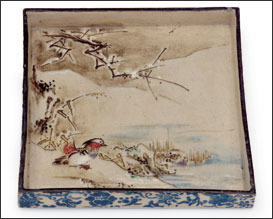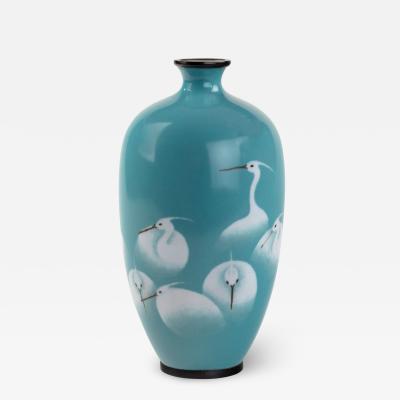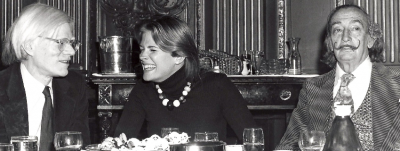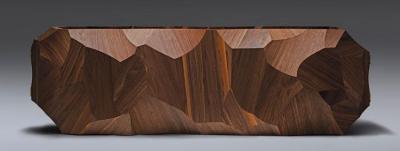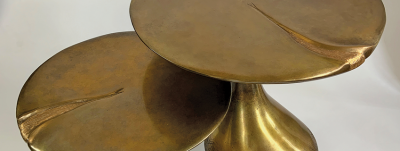The Kenzan Style in Japanese Ceramics
In Japan, potters have traditionally been professional artisans, passing skills down from generation to generation. Typically the names of individual potters were not known outside their immediate communities, the wider public being familiar only with the names of workshops or regional ceramic wares. One of the most influential figures in the history of Japanese ceramic production, however, did not follow this formula. He was born not into a potter’s family but into a wealthy merchant household, and he did not become involved with pottery production until he was in his thirties, much later than those trained in the craft. His name was associated from the start with his own work, and over time it became a “brand name,” appearing on a wealth of objects made by workshops that perpetuated the styles that he invented.
This man was Ogata Shinsei (1663–1743). Shinsei, who took on the pseudonym of Kenzan, became involved in the pottery-making business through a large measure of chance. As a younger son of a prosperous Kyoto family of textile merchants, unburdened by responsibility for the family business, Kenzan built a villa on land northwest of the city, in Narutaki village, and enjoyed his days in the pursuit of the idealized life of the “scholar-recluse,” cultivating skills in calligraphy, poetry, and painting. The most famous Kyoto potter of the seventeenth century, Nonomura Ninsei, had operated a ceramic workshop near Kenzan’s villa. After Ninsei retired, his son was unable to maintain the quality associated with his father’s production, and when the workshop failed in 1699, Kenzan acquired it, together with its staff of trained professionals and a notebook containing Ninsei’s formulas for clay bodies and glazes. It is easy to imagine that Kenzan took over the workshop on a wshim, with the idea of amusing himself with yet another gentlemanly pursuit. (A tradition of amateur pottery production was well established in the context of the tea ceremony.) He began to sign the workshop’s ceramic products with the same name he had adopted as his studio name: Kenzan—a word that indicated the northwesterly direction. In doing so, he was breaking with tradition by promoting both his persona and his artistic achievements.
Kenzan was not a potter in the sense of someone who is involved in all the workshop processes from mixing clay to firing the kiln. Rather, Kenzan’s contribution was to invent modes of decoration, drawing on his education and experience within Kyoto’s cultured merchant class for inspiration, and guiding his staff of Ninsei-trained specialists in the execution of his designs. His elegant and witty ceramics, circulated at first among his friends, seem to have enjoyed rapid success (Fig. 1), for by 1712, Kenzan had relocated his workshop to the commercial heart of Kyoto. Discovering his entrepreneurial bent, he began marketing his wares to a broader audience, producing larger quantities of ceramics with simpler designs (Fig. 2). This tactic was evidently successful, for a tourist guide to Kyoto of the time mentioned “Kenzan ware” as an essential souvenir for the traveler. Kenzan moved once more, around 1731, to Edo, where he worked among potters in the Iriya district until his death in 1743.
Kenzan is associated with six major modes of decoration, which recent scholarship has categorized as: “native poetics,” “scholar-recluse,” “utsushi,” “Korin,” “Kenzan,” and the “Raku” modes.1 The breadth of these modes is recorded in the remarkable collection formed by Charles Lang Freer (1854–1919) during his trips to Japan between 1894 and 1911 that now comprises most of the collection of Kenzan ware in the Smithsonian Institution’s Freer Gallery of Art.
The first two identified styles reflect not just Kenzan’s personal pursuits but also the cultural interests of his social circle. Decorative schemes in the native poetics mode include images and verse from ancient Japanese waka poetry and N¯o drama. A square dish, from a set of twelve (Fig. 3), and a delicately-molded container for incense pellets or possibly seal paste (Fig. 4) illustrate various months from a famous poem sequence, Flowers and Birds of the Twelve Months, by the medieval-era Kyoto courtier Fujiwara Teika (1162–1241). The colored pigments used to render these motifs evoke the soft, lyrical style of the yamato-e mode of painting associated with the Japanese court, as does the subject matter drawn from Japanese literature and poetry.
The scholar-recluse mode also reflects Kenzan’s personal and cultural ideas. On ceramics of this genre, fragments of Chinese poetry and Chinese-inspired images of huts amid mountain landscapes are brushed in shades of brown and blue-black, replicating the effect of ink on paper or silk (Fig. 5). These scenes illustrate a pristine natural world that the virtuous scholar-recluse might ponder—such introspective intellectual pursuits were deemed a worthy activity by polite society.
Utsushi (translated as “copying with a difference”) wares reinterpret various East Asian and even European ceramic modes made famous a century earlier in the context of the tea ceremony and its associated meal. Kenzan embraced ceramics and decorative schemes from other cultures in part to demonstrate his command of his material (Fig. 6). His utsushi ceramics also answered a growing demand for imports, the availability of which were hampered through trade restrictions.
After Kenzan moved his workshop into the city of Kyoto, the commercial scale of his production necessitated the use of standardized forms such as bowls, plates, and jars, and called for simplified, large-scale motifs of flowers and grasses (Fig. 7). Imagery from early-seventeenth-century paintings and illustrated books served as inspiration for this style of decoration. These brightly-colored, evocative designs would come to be seen as the essential Kenzan mode.
Kenzan collaborated with his older brother, the painter Ogata K¯orin (1658–1716), on a series of ceramics bearing K¯orin’s radically simplified designs of flowers, plants and figures (Fig. 8) and now identified as the K¯orin mode. K¯orin’s manner of painting embodied a lighthearted element associated with the chic urban lifestyle he enjoyed. Because of K¯orin’s awareness of what the social elite wanted, this phase of Kenzan ware proved quite popular among that segment of the population.
The Raku mode illustrates the reality that the Kenzan style, while originating in the design innovations of Ogata Kenzan, ultimately was greater in scope and duration than its originator. Raku ware (named after another Kyoto pottery workshop) was a soft-bodied, hand-modeled ceramic used primarily for vessels associated with the tea ceremony. Though Kenzan himself never produced Raku, many later potters applied Kenzan-style motifs to Raku-ware vessels (Fig. 9).
The Kenzan style was perpetuated and developed within workshops in both Kyoto and Edo throughout the eighteenth and nineteenth centuries, leading in the 1880s to the production of both honest and otherwise intentioned “imitations” of the master’s work expressly aimed at the new market of international collectors. In Japan today, the “Kenzan style” remains a vibrant and universally-recognized mode of ceramic decoration.
A special exhibition currently on view at the Freer Gallery of Art, Smithsonian Institution, through 27 October 2002, The Potter’s Brush: The Kenzan Style in Japanese Ceramics, presents The Freer Gallery of Art’s complete collection of nearly one hundred Kenzan-style ceramics. A book by the same name, written by Richard L. Wilson, explores the nature of this celebrated category of Japanese ceramic ware.
-----
Louise Allison Cort is Curator for Ceramics, Freer Gallery of Art and Arthur M. Sackler Gallery, Smithsonian Institution, Washington, D.C.





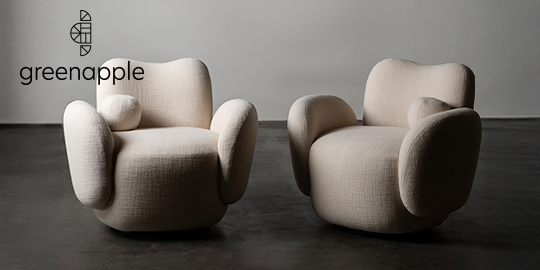









1.jpg)
.jpg)
